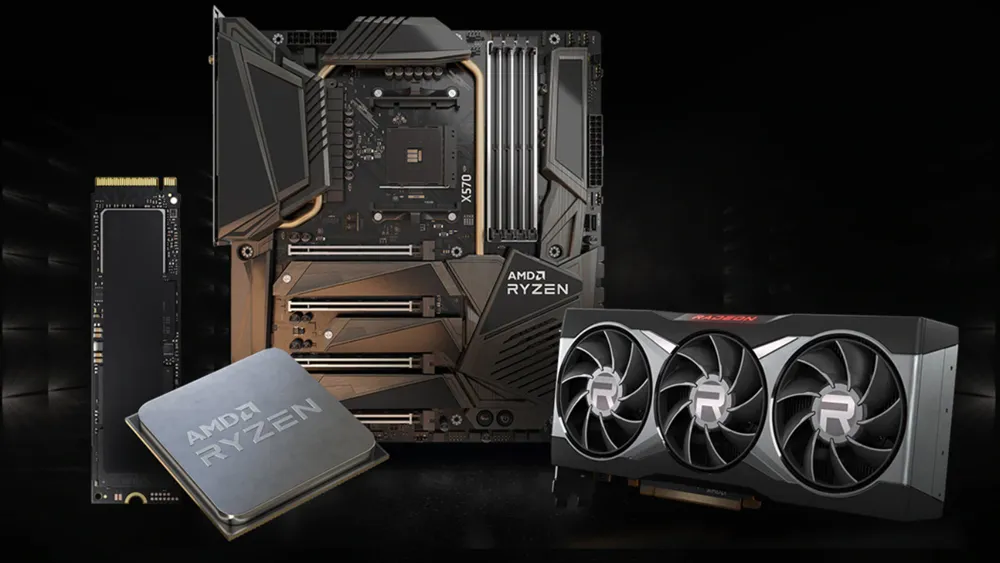AMD showed off a proprietary new technology called Smart Access Memory during its RDNA 2/Radeon RX 6000 Series reveal late last month. If you remember the charts that showed Big Navi edging out the Nvidia competition, you might also recall the notation about how the results were achieved. The combination of AMD’s Rage Mode performance profile and more importantly, Smart Access Memory, allowed the company to claim some winning numbers.
Smart Access Memory is a technology that basically allows the CPU to access the memory of the GPU more efficiently. The implementation of PCIe 4.0 and the greater bandwidth it provides makes this possible over previous limitations. Data transfers between the two pieces of hardware were previously limited to 256 megabytes, but the advances of newer PCIe support allow for data to move by gigabyte volumes now. As memory/cache volumes increase across the various components in PC systems, the connections need to do the same as well. In this case, AMD removed a bottleneck for its new hardware to perform even better when working together and the result is better gaming performance.
To put that into perspective here’s a quick reference of measured performance gains with Smart Access Memory enabled. We can see up to 11% improvements for games like Forza Horizon 4 while most other titles fall into about the 5% improvement range. These aren’t always huge gains, but every bit helps as I always say.

The competition isn’t happy and that’s great
Of course with the new generation of hardware being extremely competitive, these small advantages are enough to ruffle the feathers of those at Intel and Nvidia. As reported by Gamer’s Nexus, the Green team particularly doesn’t want to see AMD take the lead, so it’s done exactly what any company would do. Down in the neon-green labs of Nvidia, the engineers have created an open-ended version of Smart Access Memory that will work on the Ampere cards and Intel CPUs. The team even took things a step further to include functionality with PCIe 3.0.
From NVIDIA, re:SAM: “The capability for resizable BAR is part of the PCI Express spec. NVIDIA hardware supports this functionality and will enable it on Ampere GPUs through future software updates. We have it working internally and are seeing similar performance results."
— GamersNexus (@GamersNexus) November 12, 2020
Apparently, this will make the concept behind Smart Access Memory (called resizable BAR) available to anyone with the supported PCIe specs and offer performance gains to more of us soon. We’re still waiting to see if this will work between Ryzen 5000 Series CPUs and Nvidia Ampere cards, but it seems to be the case since it’s a feature of PCIe itself.
As for when we can expect an Nvidia equivalent to SAM, no date was offered, but Nvidia promised to deliver it through future firmware updates.
Innovation and ambition
This seems to be a swift and decisive attempt by Nvidia to knock one of AMD’s competitive advantages down before it has a chance to run off with the market. Overall, it’s good news for us as this is exactly what we want to see as consumers. When any company feels unchallenged, it can get away with performance stagnation and price gouging. We certainly saw that with Nvidia and Intel when AMD wasn’t competitive. A lot of people love to root for AMD as well, but frankly it wouldn’t surprise us if AMD became guilty of the same practice if left unchallenged for too long. As they say, competition drives innovation.
Nvidia seems to be trying to spin Smart Access Memory as a powerplay by AMD. Calling SAM a proprietary technology is probably fair, but to call foul on AMD seems a bit ridiculous for a company that has a proven track record of doing exactly that. Just consider Nvidia’s famous CUDA cores and RTX technology along with the long list of features like Nvidia Reflex, Ansel, etc. It’s a long list. I can’t think of a company that is more proprietary, besides perhaps Intel.

At the end of the day, we want to see all companies putting out exciting new products and software technologies to move the PC gaming markets forward.
Proprietary technologies are bad, but calling one company morally good or bad is not an easy sell. Intel, Nvidia, and AMD are all massive publicly-traded companies seeking to earn profits. What’s important for us as consumers is that the different tech giants compete in order to keep one another in check.







Published: Nov 13, 2020 08:00 pm